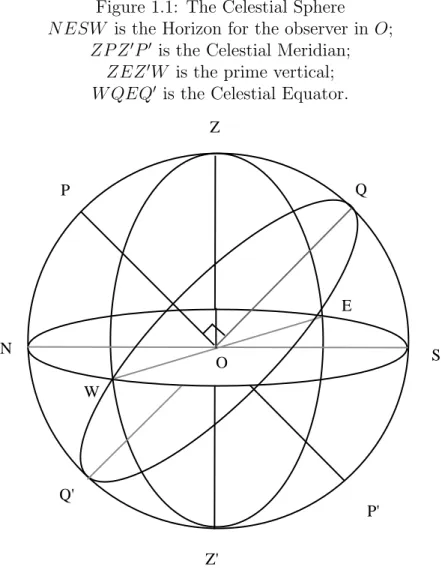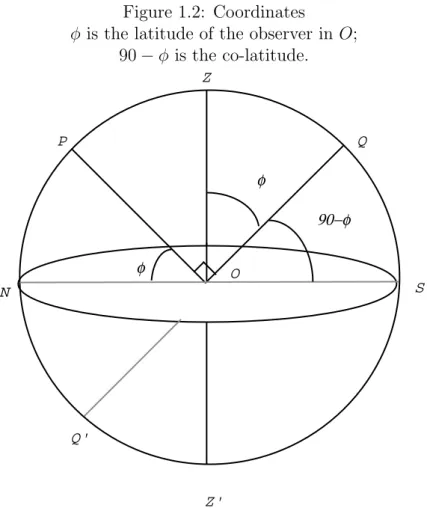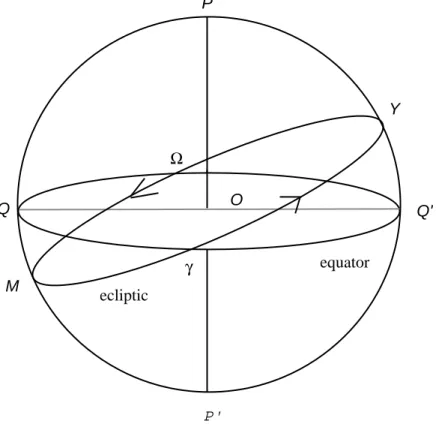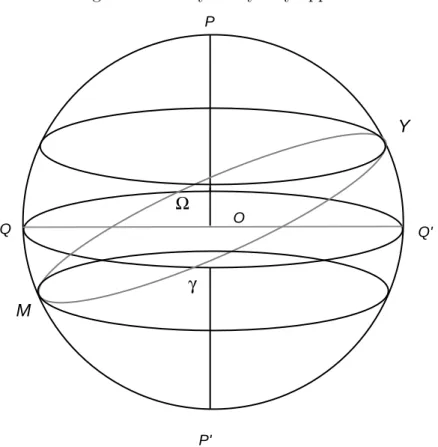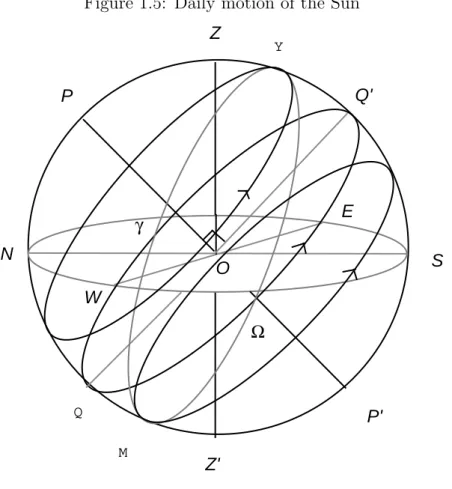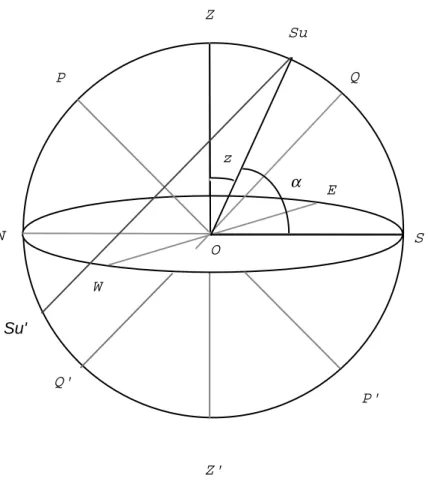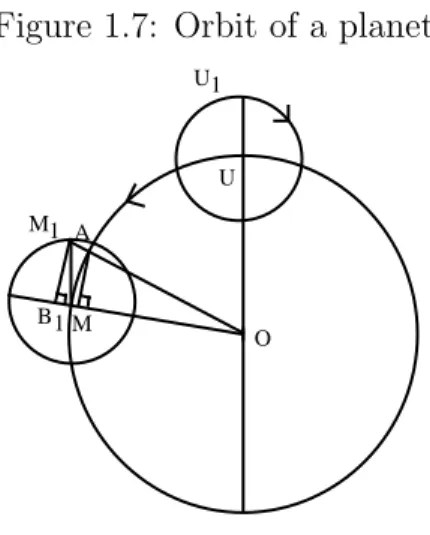HAL Id: halshs-00006348
https://halshs.archives-ouvertes.fr/halshs-00006348
Preprint submitted on 28 Nov 2005HAL is a multi-disciplinary open access archive for the deposit and dissemination of sci-entific research documents, whether they are pub-lished or not. The documents may come from teaching and research institutions in France or
L’archive ouverte pluridisciplinaire HAL, est destinée au dépôt et à la diffusion de documents scientifiques de niveau recherche, publiés ou non, émanant des établissements d’enseignement et de recherche français ou étrangers, des laboratoires
Appendix on some elements of Indian Astronomy
Agathe Keller
To cite this version:
Appendix: Some elements of
Indian Astronomy
1.1
Generalities
The sky is considered as a sphere (gola) whose radius is 3438 minutes (kal¯as)1
, with the Earth at its center. Stars are fixed on the sphere, which is thus called bhagola, “sphere of the asterisms/stars”. We will call it here the Celestial Sphere. Tradition states that the Earth does not move, and that the Celestial Sphere turns daily around the line going from the North pole (P ) to the South pole (P′) called the Celestial axis. ¯Aryabhat.a however considered that the
Earth rotated from West to East, and therefore that the movement of the Celestial Sphere was only apparent. Because of the violent reactions such a statement provoked, later commentators changed the verse in order for it to mean exactly the contrary2
. The planets, among which the Sun and the Moon, revolve in the space between the Earth and the Celestial Sphere. The Celestial Equator (vis.uvat) is defined as the great circle (i.e. a circle belonging to the sphere and having the earth for center) perpendicular to the Celestial axis.
Let us imagine an observer (O) on Earth. Since the Earth and thus the point where the observer stands is very small compared to the radius of the Celestial Sphere, both are collected together. Apart from the Celestial axis and Equator, in the following representations, all the other planes and lines will be defined according to this observer.
The imaginary vertical line which through the observer’s feet extends itself
1
The reason why a circular measuring unit is used here remains mysterious to me. 2
See for instance [Sharma-Shukla 1976; Intro, p.xxix; p. 8; p. 119-120], [Yano 1980], and [Bhattacharya 1991].
1.1. Generalities
Figure 1.1: The Celestial Sphere N ESW is the Horizon for the observer in O;
ZP Z′P′ is the Celestial Meridian;
ZEZ′W is the prime vertical;
W QEQ′ is the Celestial Equator. Z Z' N S P' P O W E Q Q'
to two points on the surface of the sphere defines respectively the Zenith (Z, nata), which is the point above, and the Nadir (Z′), which is the point below.
This is illustrated in Figure 1.1.
The great circle perpendicular to ZOZ′ is called the Horizon. The plane it
encloses is the plane of the observer. It intersects the Celestial Equator in two points called the East (E) and West (W ).
The great circle which passes through the Zenith, nadir and the poles is called the Celestial Meridian for this observer. It intersects the Horizon at the North (N ) and South (S).
The great circle perpendicular to the Celestial Meridian, passing through the Zenith and Nadir, and the the East (E) and the west (W ) is called the prime vertical (samaman.dala).
1.2
Coordinates
The latitude of the observer, O, usually noted φ, is the angular distance be-tween the Equator and the Zenith (the arc ZQ as illustrated in Figure 1.2.)
The distance of the pole to the Horizon (the arc P N ) is called the altitude of the pole. Because the angles ZOQ and P ON are equal, the altitude of the pole and the latitude of the observer are equal. The co-latitude is 90◦− φ (as
the arc QS).
Let us now consider the orbit of the Sun.
The path of the Sun in the sky relatively to the stars, and to a fixed earth, when noted during a year, at a given time, in a given place, every day, draws an ellipse. This ellipse is in fact a mirror of the motion of the Earth around the Sun. The plane defined by this ellipse intersects the Celestial Sphere in a great circle called the Ecliptic (apaman.d.ala). The Ecliptic intersects the Celestial Equator in two points γ and Ω. The angle of the Sun with the Equator is constantly changing. In γ and Ω it is zero. The points where it is the greatest is called the obliquity of the Ecliptic (param¯araprama, lit. “greatest declination”). This is illustrated in Figure 1.3.
Today this angle, which is also that of the Ecliptic with the Equator, is roughly considered to be 23◦7′. γ is the point of the Equator through which
the Sun is considered to move from the southern hemisphere to the northern hemisphere. It is called the vernal equinox. Ω is the point on the Equator through which the Sun is considered to move from the northern hemisphere to the southern hemisphere. It is called the autumnal equinox. The two points where the sun is at its greatest angular distance from the Celestial Equator are
1.2. Coordinates
Figure 1.2: Coordinates
φ is the latitude of the observer in O; 90 − φ is the co-latitude. P Z Q N Q' Z' S O φ φ 90−φ
Figure 1.3: Apparent motion of the Sun in a year γ is the vernal equinox;
Ω is the autumnal equinox; P Q O Q' P' γ Ω M Y ecliptic equator
1.2. Coordinates
Figure 1.4: Daily and yearly apparent motions of the Sun
P Q O Q' P' γ Ω M Y
called the Summer (Y ) and Winter (M ) solstice.
The Ecliptic represents the yearly path of the Sun on the Celestial Sphere. Daily, however, the Sun is considered to have a motion parallel to that of the Equator, because of the rotation of the Celestial Sphere around the axis of the poles. In fact, if we would represent the daily motions of the Sun in a year, it would appear as a spiral made of roughly 365 spins parallel to the Equator. It would be a spiral because in 24 hours the Sun slightly moves along the Ecliptic. During the vernal and autumnal equinox the apparent motion of the Sun is on the Equator. The days are equal to the nights. The day of the winter solstice is the shortest of the year. The day of the summer solstice the day is the longest of the year. Whatever the day, at mid-day the Sun is on the Celestial Meridian. This is illustrated in Figure 1.4.
Let’s take any day of the year, and consider the Sun at mid-day. As illus-trated in Figure 1.5.
The straight line SuSu′ represents the orbit of the Sun. At mid-day the
Figure 1.5: Daily motion of the Sun Z Z' N S P' P O W E Q' γ Ω M Y Q
1.3. Movement of Planets
Figure 1.6: The Sun on an equinoctial day
Z Z' N P' P O W E Q Q' z α S Su Su'
arc ZSu) is called the Zenith distance of the Sun (z). The angular distance between the Horizon and the Sun at Su is the altitude of the Sun (a).
On an equinoctial day, the Sun is on the Celestial Equator. As illustrated in Figure 1.6. At mid-day the Sun is in Q. The Zenith distance of the Sun in Q is then the latitude (aks.a) of the observer. And its altitude becomes the colatitude (avalambaka) of the observer.
These concepts are used in Bh¯askara’s commentary, when studying the astronomical interpretation of the shadow cast by a gnomon, at mid-day (in BAB.2.14).
1.3
Movement of Planets
One aspect of the Hindu planetary theory bearing trace of a Hellenistic influ-ence concerns the description of the apparent motion of planets. These are
Figure 1.7: Orbit of a planet O M M1 U U1 B1 A
rendered through an epicycle theory: the problem then being the constant dis-crepancy between the mean motions and the true ones. We will expose very briefly here some elements of Bh¯askara’s epicyclic theory. For a more detailed analysis see the explanations given in Chapter IV of [Shukla 1960].
A planet G (graha) has a mean circular motion, along a great circle of the Celestial Sphere, the deferent, called in Bh¯askara’s commentary vy¯as¯ardha-man.d.ala (“the circle hof thati semi-diameter”). ¯Aryabhat.a calls it kaks.y¯aman.d.ala (Ab.3.18) “orbit’s circle”. Let O, the earth, be its center, and R, the radius of the celestial sphere, its radius. This is illustrated in figure 1.7.
However, at a specific time of a specific day, the tabulated position of G is considered to be on a second smaller circle, the epicycle (pratiman.d.ala), which revolves in a direction opposite to the revolution described by the deferent. Although the point on the epicycle, representing G at that time on that day is not yet the true position of G it is considered a first, better approximation of it.
Let U1 be the apogee (ucca) of G. Bh¯askara defines in BAB.3.4ab
[Sharma-Shukla 1976; p.179, line22-23], the ucca as follows:
yatra grah¯ah. s¯uks.m¯a laks.ayante (Shukla’s readings)/labhyante (Mss. reading) karn.asya mahattv¯at sa ¯ak¯a´saprade´sa uccasam. j˜nitah.
That we can understand as follows:
A spot in the sky where a planet is perceived to be small because of the greatness of the hypotenuse (karn.a) is called ucca (high).
The apogee is the apparent remotest point of G along its orbit. And U its mean position along its orbit. U U1 serves as reference both for the radius of
1.4. Time cycles
the epicycle at any time, and for the exact place on the epicycle where the tabulated position of G on the epicycle should be.
Let M be the mean position of G on its circular orbit on a given day at a given time. The arc U M represents the mean arcual distance of G to its apogee at that given time, and is called the bhuj¯a. Let M1 be an approximation
of the true position of G when its mean position is in M . M1 is such that
M M1 = U U1. This defines the epicycle. In his commentary to Ab.2.26-27.ab.
Bh¯askara does not consider the epicycle itself, but the circle having for radius OM1: tatk¯alotpannakarn.avis.kambh¯ardhaman.d.ala (the circle which has for
semi-diameter the hypotenuse produced at that time).
Let A be the point of OM1 that intersects with the mean orbit of G. Let
B be a point of (M O) such that AB is perpendicular to (M O). Let B1 be a
point of (M O) such that M1B1 is perpendicular to (M O). Both AB and M1B1
are called the bhuj¯aphala (the correction of the bhuj¯a). OA is the radius of the orbit (vy¯as¯ardha) and OM1 is called the hypotenuse (karn.a).
Bh¯askara states in BAB.2.26-27.ab. that: AB
OA =
B1M1
OM1
.
And thus that AB is inversely proportionate to OM1.
This section and the following, gives several supplementary remarks on the astronomical aspects of BAB.2.32-33.
1.4
Time cycles
Traditional hinduism considers time as cyclical: there are four ages, called yugas, at the end of which the universe is destroyed and reborn again. The four yugas, in which the conditions of life increasingly deteriorates are in due order: the kr.tayuga, the tret¯ayuga, the dv¯aparayuga, and the kaliyuga in which we presently live.
Ab.1.3-4 gives the numbers of revolutions of the sun, moon, earth etc. in a yuga, and the date of the beginning of the current yuga. Ab.3.5 defines solar years (sam. vatsara), lunar months and civil and sidereal days. A solar year is defined by the time taken by the Sun, apparently, to make a full rotation around the earth. The number of solar revolutions, which gives the number of years, in a yuga is stated to be 4 320 000.
Traditional astronomy also distinguishes between civil days (bh¯udivasa/dina, lit. terrestrial days) and celestial ones (naks.atradivasa). A celestial day, cor-responds to one apparent rotation of the celestial sphere from East to West.
A civil day, corresponds to the daily apparent rotation of the sun around the earth: since the sun every day slides slightly on the ecliptic there is a discrep-ancy between celestial and civil days.
The civil days are defined in Ab.3.5: “The conjunctions of the Sun and the Earth are (civil) days”3
. The computation of the number of conjunctions in a yuga is defined in Ab.3.3ab: “The difference between the revolution-numbers of any two planets is the number of conjunctions of those planets in a yuga.”
4
The “revolution-number” (bhagan.a) of a planet is the number of revolutions of a planet in a yuga: these are constant and given in Ab.3-4. The number of terrestrial revolutions in a yuga is given by ¯Aryabhat.a in Ab.1.3: 1582237500. So that the number of civil days in a yuga (Ay
5
) is equal to the number of revolutions of the Sun in a yuga minus the number of revolutions of the earth in a yuga: 1582237500 − 4320000 = 1577917500. Therefore Ay = 1577917500.
This value is important when evaluating the number of days elapsed in the Kaliyuga, when the longitude of a given planet is known. This is one of the astronomical problems solved by a pulverizer computation, as described by Bh¯askara in BAB.2.32-33.
1.5
Orbits and non integral residues of
revo-lutions
The mean orbit (kaks.y¯a) of a planet, as we have seen above, is considered to be a circle (kaks.y¯avr.tta). It represents tha apparent motion of a planet, around the earth, on the Celestial sphere. One movement of the planet along its orbit is called a revolution (man.d.ala). A revolution is divided into twelve equal signs (r¯a´si). A revolution is also divided into three hundred and sixty degrees (bh¯aga), so that there are thirty degrees per sign. A degree is divided into sixty minutes (lipt¯a), a minute into sixty seconds (vikal¯a)6
. This is summed up in Table 1.1.
At the beginning and at the end of a yuga, all planets are in conjunction. It is assumed, that along their respective orbits, all the planets cross the same distance in a yuga. This is stated in Ab. 3. 12. (op. cit. p. 100). The distance described by any planet in a yuga gives the “circumference of the sky”7
. In 3 [Sharma-Shukla 1976; p. 91]. 4 op. cit., p.86. 5
This corresponds to the notations we have adopted in our supplement for BAB.2.32-33 6
These subdivisions, of course, recover those that divide a circle in mathematics. See the Section of the Glossary on Time Units.
7
1.5. Orbits and non integral residues of revolutions
Table 1.1: The different subdivisions of a Revolution
Sanskrit English Respective Amounts
Rev Signs Deg Min Seconds
man.d.ala Revolution 1
r¯a´si Sign 12 1
bh¯aga Degree 360 30 1
lipt¯a Minute 216000 300 60 1
vikal¯a Second 1296000 18000 3600 60 1
verse 6 of the G¯ıtik¯ap¯ada, ¯Aryabhat.a gives the following rule (given here with the non-literal translation by K.S.Shukla and K.V. Sharma op. cit., p.13) to compute the length in yojanas of the orbit of any planet:
Ab.1.6.
khayug¯am. ´se grahajavo
The circumference of the sky divided by the revolutions of a planet in a yuga gives (the length of) the orbit on which the planet moves.
From this verse of the ¯Aryabhat.¯ıya we also indirectly know that, the cir-cumference of the sky in yojanas is: 12474720576000 yojanas. The orbit of the Moon, according to the value given in Ab.1.3 is
12474720576000
57753336 = 216000 yojanas.
And the orbit of the Sun is
12474720576000
4320000 = 2887666, 8.
In the Mah¯abh¯askar¯ıya, the following verse gives a rule to find the mean longitude of a planet8
: Mbh.i.20
ambaroruparidhir vibh¯ajito bh¯udinair divasayojan¯ani taih.|
sa ˙ngun.ayya divas¯an ath¯a haret kaks.yay¯a bhagan.ar¯a´sayah. svay¯ak Divide the (yojanas of the) circumference of the sky by the num-ber of civil days (in a yuga): the result is the numnum-ber of yojanas traversed (by a planet) per day. By those (yojanas) multiply the
8
ahargan.a and then divide (the product) by the length (in yojanas) of the own orbit of the planet. From that are obtained the revolu-tions, signs, etc. (of the mean longitude of the planet).
The ahargan.a, is the number of days elapsed in the Kaliyuga at that time. If x is the ahargan.a, since we know that the number of civil days in a yuga is 1577917500, then, for example, the mean longitude of the Sun (λS) is:
λS =
12474720576000x 1577917500 × 2887666, 8.
We can recognize here the type of problem solved by pulverizer without remainder. Such problems are seen in Examples 24-26 of BAB.2.32-33. Note that there would be an obvious simplification here, that does not seem to be carried out in the resolution of these examples:
λS = 12474720576000x 1577917500 × 4320000 12474720576000 = 4320000x 1577917500 = 576x 210389
